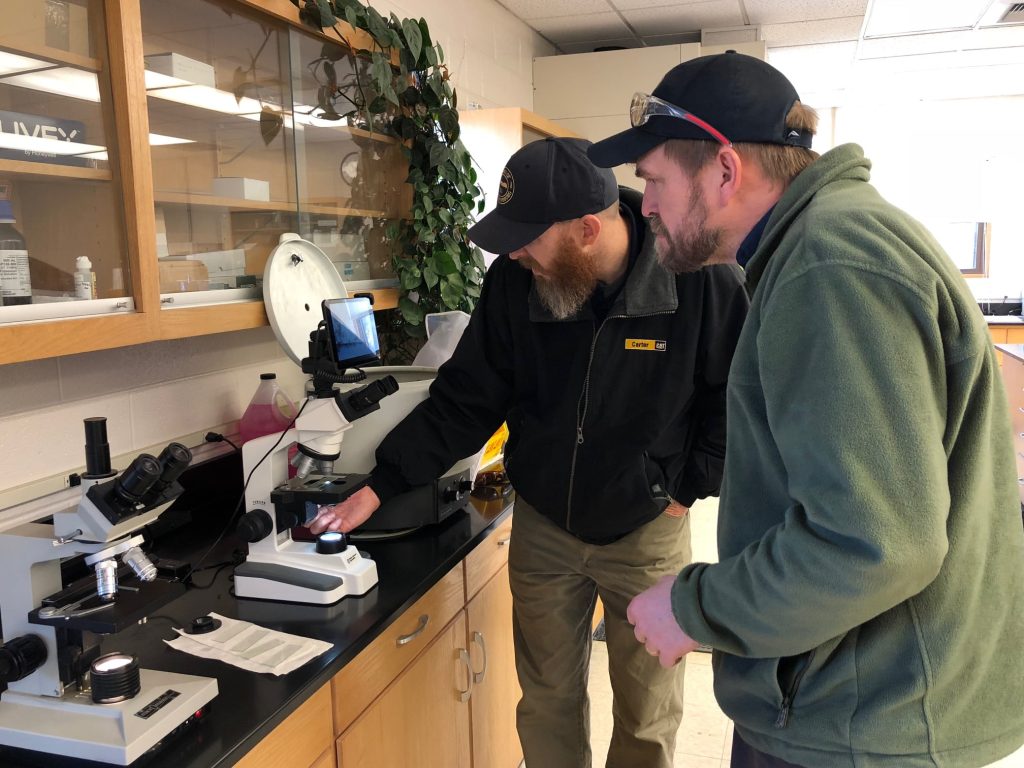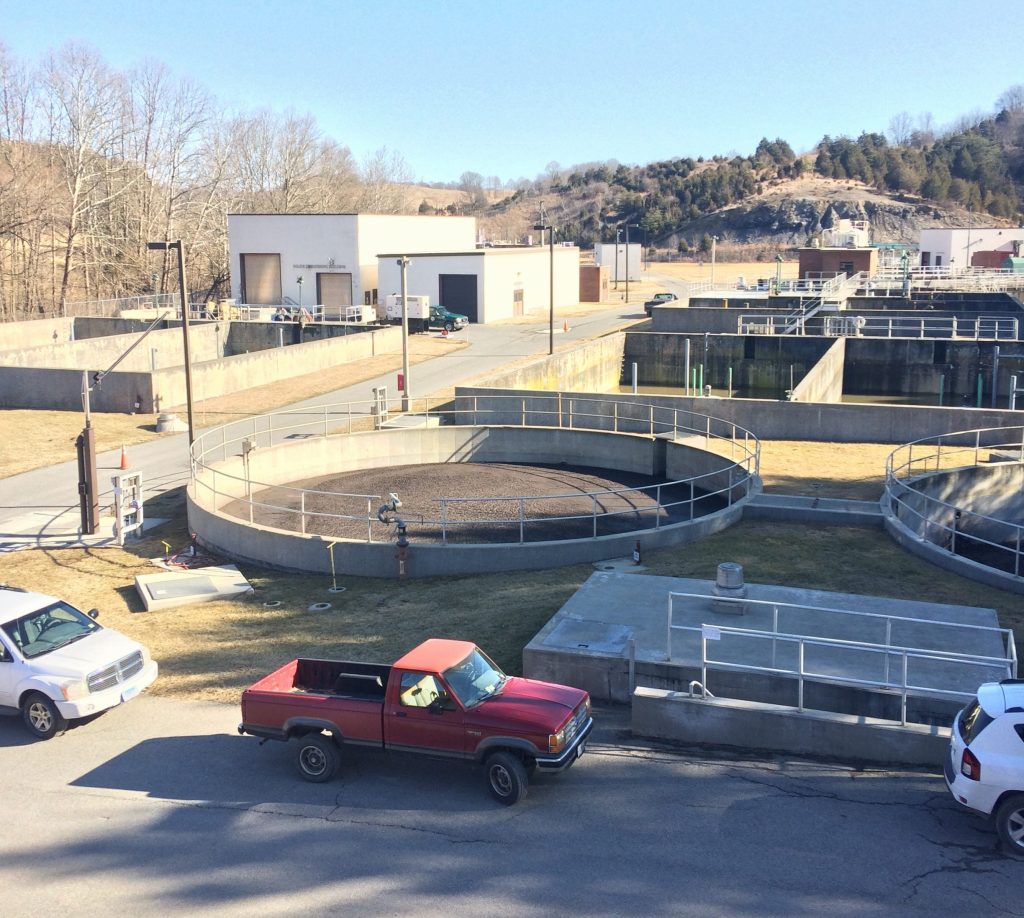
In the facility’s laboratory, Ryan Hendrix, wastewater operations superintendent (left) and John Shelor show visitors how microscopic organisms are monitored. Key to protecting a community’s public and environmental health, monitoring the biological and chemical aspects of wastewater treatment is part of the daily routine.
As the muddy washboard of Crab Creek Road winds through yellow pasture and down to the chain-link fence, concrete settling tanks and trim brick buildings of the Christiansburg Waste Water Treatment Facility, it all seems far away from the busy town, out of sight beyond the woods.
The plant may be out of sight to many, but so critical is its job to the town’s public and environmental health, and its prospects for economic development that the facility holds tours, explores innovative green energy production and keeps the whole system running while battling to educate an oblivious public in a disposable economy.
The facility hosts at least 20 public education tours a year. University engineering and biological sciences students, elementary school students and the town’s Citizen’s Academy—any curious person interested in getting a behind-the-scenes look at a town’s inner workings needs to understand where its water goes once it leaves a sink, shower or toilet.
Ryan Hendrix, wastewater operations superintendent, tall and bearded, accompanied by John Shelor, wastewater operations supervisor, leads the tour of the 40-year-old facility.
Throughout the country many municipalities, squeamish about raising rates and failing to imagine the consequences, have neglected to invest in this primary infrastructure, but Christiansburg has always understood the importance of its wastewater treatment facility.
“Because without this, you can’t bring economic development,” Hendrix said. “One of the first things a new industry asks is ‘How much water can you get to me and can you handle this load of waste?’ So, that starts right here. If a town can’t accept that, they say, ‘We’re going to Roanoke.’”
Steady investment pays off. The tour begins in the very tidy control room where sleek wrap-around computer displays blink and hum. It’s here that licensed, skilled technicians make day-to-day decisions on how to operate the plant that runs 24-hours a day 365 days a year. Someone’s always here managing the 2.5 million gallons of wastewater that pour in.
“Every pump, motor, gate, has a signal we can see in a snap shot,” Hendrix said. “This was about $500,000. An alarm might go off if it rained really hard, or a pump stops. It happens two to three times a week. Rain is planned around, but it’s more when you have a power flicker. [It] shuts everything off, and we need to make sure we’re producing clean water and meeting regulations.”
The sleek new monitoring system stands beside the old system—a grey lump the size of a refrigerator where an inked needle scratches data on a slowly revolving paper disc, visible through a porthole, like a WWII submarine.
“Everything here has a backup,” Hendrix said. “There’s a backup to a backup. When a system goes down, you immediately go over here to understand what’s happening. There’s always something.”
Like infrastructure upgrades and system backups, the skills and minds at work here need backing up too.
“It’s been like the nursing industry,” says Hendrix, “They had a huge “brain drain,” so many people were retiring and those skills were at a premium.”
It was the same with water infrastructure. Most people in the industry are between 30 and 50 years old, according to Hendrix. There was concern about young people entering the field.
“But now, they’re starting to come in. For public works as a whole, recruiting is a pretty big deal.”
Clean water and waste disposal is so basic to a healthy, functioning town, Hendrix has worked in wastewater treatment for 22 years. He’s worked in four different states, and he’s never been without a job.
“Working in water is a sustainable career,” he said. “Engineering, science, accounting, mechanical, welding, laboratory, and the larger the facility is, the more of those things there are.”
Quiz questions on a whiteboard ask, “Which mask do you use for aerosols?”
This highly technical field everybody has to have a license with years of experience and constant test taking. The town is helping them study.
The tour moves on to a sunny lab, where visitors look through a microscope at a murky sample scooped from a tank that morning at stalked ciliates, organisms shaped like lollipops and dandelions that anchor themselves and spend their time just beating waste into their hair-ringed mouths. The more stalks you see, the better the treatment system is working.
“It’s like a whale. They filter the bacteria and then clean water comes out,” Hendrix said. By sampling and counting the ciliates, the lab takes a picture of the biodiversity of the system.”
Both complex and simple wastewater—the waste part—is eaten by living microorganisms, consumed before the water can be discharged into the New River.
Following the 1972 Clean Water Act, water is so clean when it is sent back out into the river that the pipe that discharges the newly cleaned water from the Christiansburg plant is upstream from the drinking water intake pipe.
Asked whether that’s a good idea, Hendrix points out, “Everyone lives downstream.”
The tour is a series of both “Ew” and “That’s amazing”—a reenactment of the natural process of microbial consumption—the plant just speeds up the natural process.
All that tweaking and toggling, daily test, blinking lights and alarms tells the technicians whether the system is working well, maintaining a blob of microorganisms.
But this blob of living microorganisms is all that stands between the toilets and kitchens, the industries of Christiansburg and the fish and kayakers in the New River. That blob can be killed or hurt by poisons coming from the homes and industry.
“We’re constantly looking at toxics,” Hendrix said.
Motor oil, drain cleaner, oven cleaners, nail polish, broken thermometers and rat poison end up going down the drain.
“Anything somebody puts in a manhole or flushes. In 2006, illegal dumping killed most of the plant,” he said.

Out of sight, but not out of mind, dependable wastewater treatment is at the bottom of a healthy, productive town. The Christiansburg Waste Water Treatment Facility hosts tours, explores innovation and keeps the whole fragile system running.
That was an illegal septic hauler who pulled up a manhole cover and dumped his load, impacting Crab Creek, Pepper’s Ferry and Blacksburg’s wastewater treatment plants.
What happens to the person who poisoned the water? Not much.
“He was supposed to go to jail, but environmental crime is a little less sought after. It’s gotten better,” Hendrix said.
Not as dramatic as toxics, but damaging and expensive to clean is the day-to-day stuff people drop down toilets: bits of plastic, tampon applicators, microbeads and wipes that are too durable to breakdown are filtered out by the ton, even the silica that makes body lotion silky clogs equipment.
Pharmaceuticals are the new danger to a functioning treatment system and a healthy river.
To deal with these emerging contaminants, technology changes are coming hard and fast and a smart water treatment plant has to be knowledgeable of the latest developments and trends.
The staff stays up to date on research and remains active with national water associations. As a result, Christiansburg’s plant invests in new equipment that allows it to prepare for regulations that haven’t even arrived yet.
It’s another example of where Christiansburg is invested in their utilities according to Hendrix. The next big regulation coming is ammonia treatment.
Ammonia is toxic to shellfish, but it’s been something water treatment facilities hadn’t tested for.
“Our water is full of shellfish. There will be regulation to treat for ammonia, but the thing is, we’re already doing it. We’re well ahead,” Hendrix said.
Municipalities that are behind, that haven’t anticipated change or didn’t have the political will to prepare for it, have to find the money and the knowledge—build an institutional infrastructure within the physical infrastructure—to catch up to modern regulations.
A nimble facility anticipates regulatory requirements, while at the same time being efficient and sustainable.
As part of a stimulus package following the 2008 recession, the plant bought equipment to capture the methane produced by the system, and uses it to power the energy-hungry aeration system.
With a professor at Virginia Tech, the facility is mulling ways to harness the food-waste stream from the VT campus’ dining halls to generate energy that can be sold to the electric company, thus making a return for the town’s investment.
The tour follows the water flow. From the influent pump station, the tour marches out across clanking grates over frothing murk (“Don’t drop your phone,” Hendrix said) to the ultraviolet light glow of the Effluent station before being discharged into the New River.
As the country enters into conversation around investment needed to prop up a woefully sagging national water and wastewater infrastructure, Christiansburg has been proactive all along.
And, in the end, these smart, eye-opening tours are part of Christiansburg’s smart water system.
They are a demonstration of the wastewater treatment plant doing critical work efficiently and creatively, a place where students get good jobs, and a smart staff wrestles with day-to-day challenges, anticipating what’s coming over the gunnels.
For more information and to take a tour of the facility, contact Hendrix at 382-8221 or rhendrix@christiansburg.org.



